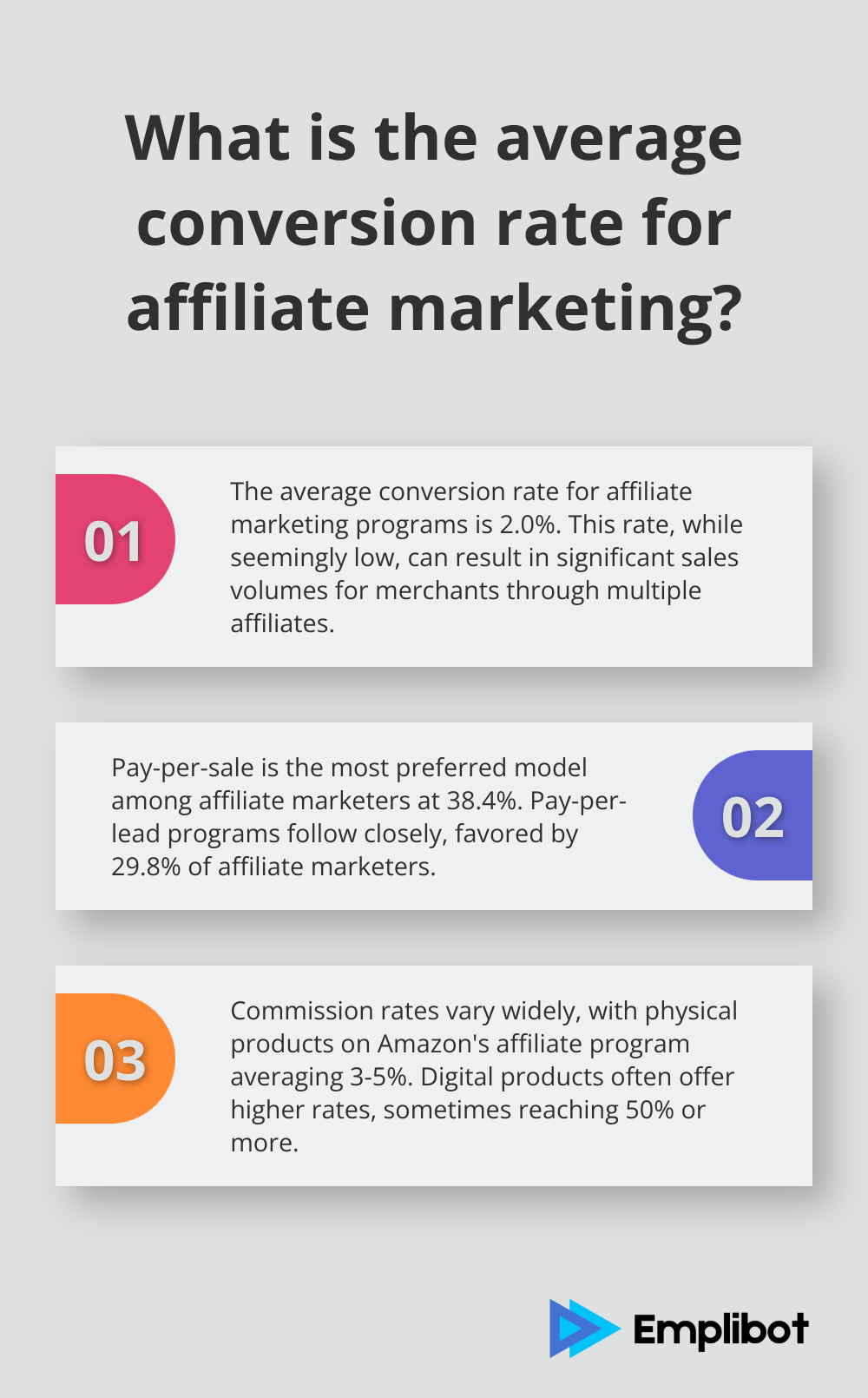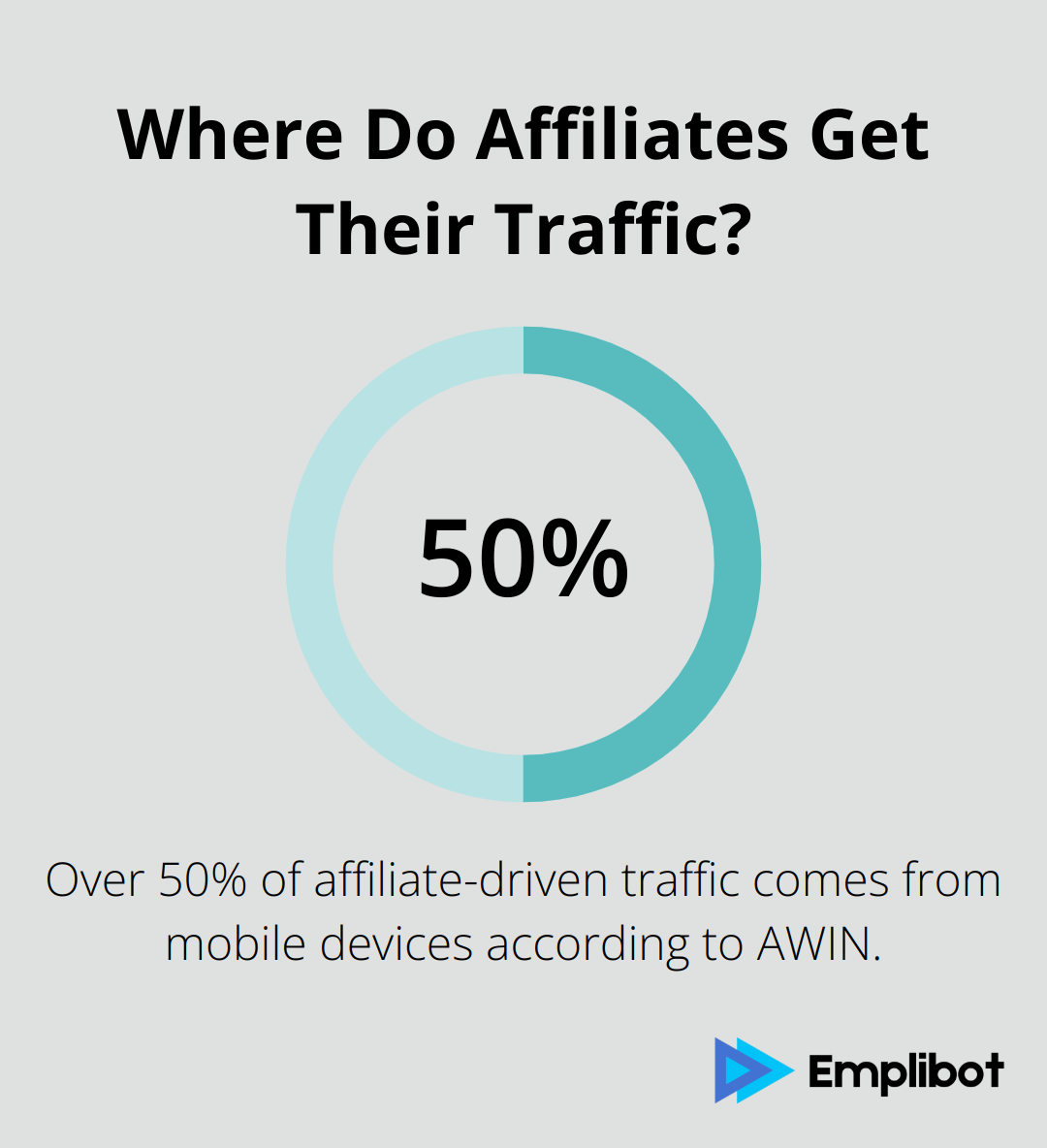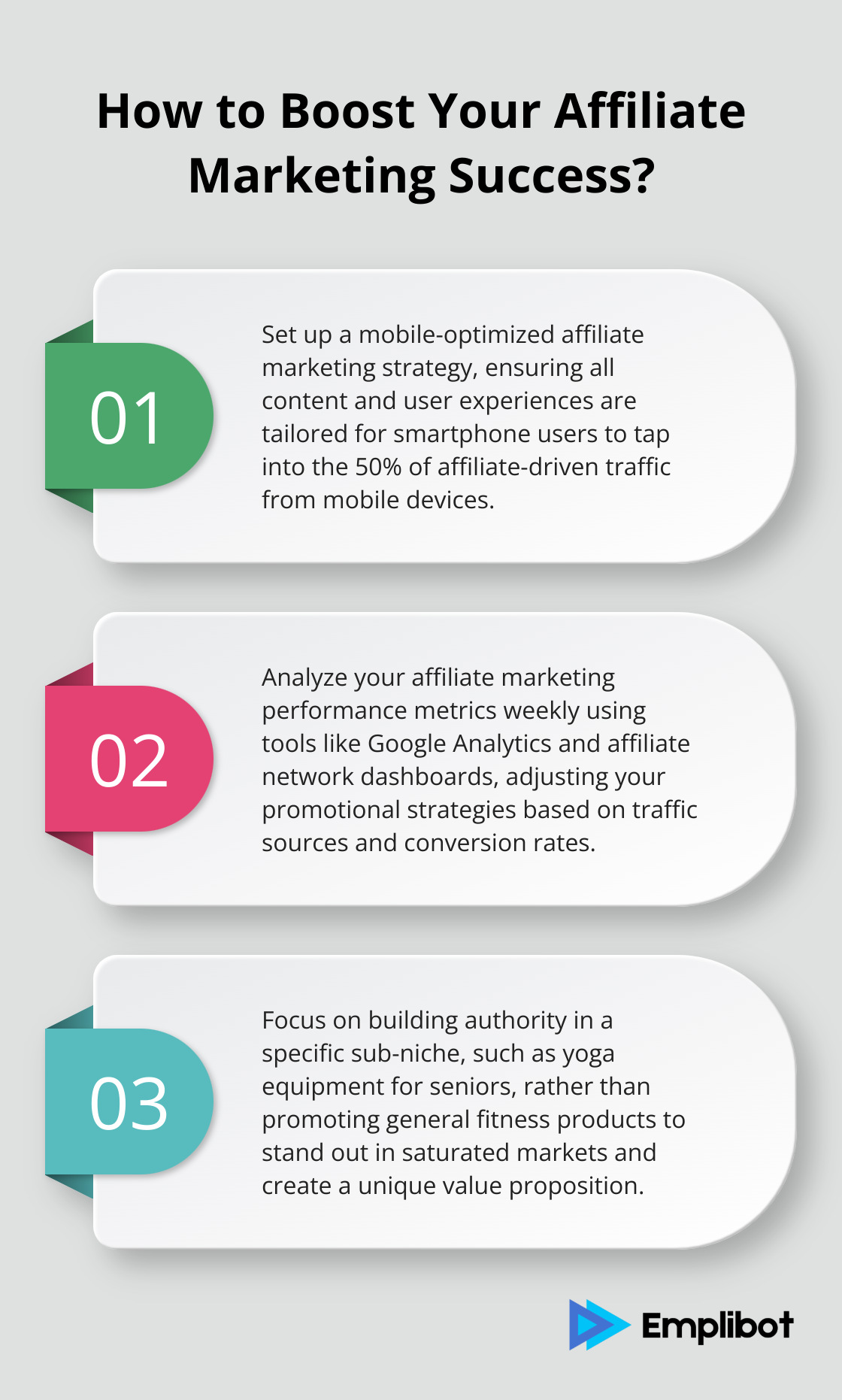Affiliate marketing has become a cornerstone of digital commerce, yet many still struggle to grasp its full potential. At Emplibot, we’ve seen firsthand how this powerful strategy can transform businesses and create new income streams for savvy marketers.
In this post, we’ll explore the definition of affiliate marketing and break down its key components. We’ll also delve into the mechanics, benefits, and challenges of this dynamic field, providing you with a comprehensive understanding of how it works.
Contents
ToggleWhat Is Affiliate Marketing
The Three-Pronged Approach
Performance Marketing is a comprehensive term that refers to online marketing and advertising programs in which advertisers pay partners based on specific actions or results. It expands a company’s reach without the upfront costs of traditional advertising. This model involves three key players: the merchant (advertiser or retailer), the affiliate (publisher), and the customer. The merchant sells a product or service, the affiliate promotes the merchant’s offerings through various channels, and the customer makes a purchase based on the affiliate’s recommendation.
Commission-Based Rewards
The pay-for-performance structure sets affiliate marketing apart from traditional advertising. Companies only reward partners when specific actions occur (such as clicks, lead generation, or sales). This structure contrasts with traditional advertising, where companies pay for ad space regardless of results.
Tracking and Attribution
Affiliate marketing relies on the ability to track and attribute sales to specific affiliates. This process typically uses unique affiliate links or promo codes. When a customer clicks on an affiliate’s link and completes a purchase, the sale credits to that affiliate.
Diverse Promotional Methods
Affiliates use a wide array of promotional methods to reach potential customers. These methods include:
- Product reviews on blogs
- Social media posts
- Email marketing campaigns
- YouTube videos
This flexibility allows affiliates to choose strategies that best resonate with their audience (and maximize their earning potential).
Risk Mitigation for Merchants
Affiliate marketing offers merchants a way to mitigate risk in their advertising efforts. Since payment typically bases on performance, merchants only pay when they achieve desired outcomes. This approach makes it an attractive option for businesses that want to expand their reach without significant upfront costs.

As of 2016, 84% of publishers and 81% of brands had adopted affiliate marketing. According to Google Trends, search interest in the term has been growing steadily.
As we move forward, we’ll explore how affiliate marketing works in practice, including the various types of programs and commission structures that drive this dynamic industry.
How Affiliate Marketing Works
The Affiliate Marketing Process
Affiliate marketing is a performance-based strategy where publishers, or affiliates, earn commissions for promoting products or services. This marketing approach rewards performance, where affiliates earn money by promoting products or services for merchants.

The process starts when a merchant creates an affiliate program and recruits partners to promote their offerings. Affiliates incorporate product links or promotional content into their websites, social media channels, or email campaigns. When a potential customer clicks on these affiliate links and makes a purchase, the sale attributes to the affiliate, who earns a commission.
A study reveals that the average conversion rate for affiliate marketing programs is 2.0%. While this percentage may appear low, the cumulative effect of multiple affiliates can lead to significant sales volumes for merchants.
Types of Affiliate Programs
Affiliate programs come in various forms, each suited to different business needs and marketing strategies. Some popular types include:
- Pay-per-sale (PPS): The most common model, where affiliates earn a percentage of the sale value.
- Pay-per-lead (PPL): Affiliates receive compensation for generating qualified leads, regardless of whether a sale occurs.
- Pay-per-click (PPC): Affiliates earn money based on the number of clicks their promotional efforts generate.
A survey by AM Navigator showed that 38.4% of affiliate marketers prefer the pay-per-sale model, while 29.8% favor pay-per-lead programs. This preference likely stems from the potential for higher earnings with successful sales conversions.
Commission Structures and Payment Models
Commission rates vary widely across industries and products. For example, the average commission rate for physical products on Amazon’s affiliate program ranges from 3-5%, while digital products often offer higher rates (sometimes reaching 50% or more).
Some programs use tiered commission structures, where affiliates can earn higher rates as they generate more sales. This approach incentivizes affiliates to increase their promotional efforts and rewards top performers.
Payment models also differ among affiliate programs. While many offer monthly payouts, some provide weekly or even daily payments. The payment threshold – the minimum amount an affiliate must earn before receiving a payout – can range from $10 to $100 or more, depending on the program.
Tracking Technologies
Accurate tracking forms the backbone of successful affiliate marketing. Most programs use cookies to track user activity and attribute sales to the correct affiliate. Cookie duration can significantly impact an affiliate’s earning potential, with some programs offering 24-hour cookies while others extend to 30 days or more.
More sophisticated tracking methods include postback URLs and server-to-server tracking, which offer improved accuracy and can bypass ad-blockers that might interfere with traditional cookie-based tracking.
As affiliate marketing continues to evolve, new technologies like blockchain emerge as potential game-changers for tracking and transparency. These innovations promise to reduce fraud and provide more accurate, real-time data on affiliate performance.
The next chapter will explore the benefits and challenges of affiliate marketing, shedding light on why this strategy has become so popular among businesses and marketers alike.
Why Affiliate Marketing Works
Advantages for Merchants and Affiliates
Affiliate marketing has become a powerhouse in the digital landscape, offering unique advantages for both merchants and affiliates. For merchants, this strategy provides a cost-effective way to expand reach and boost sales. Unlike traditional advertising where costs occur upfront, affiliate marketing operates on a performance-based model. Merchants only pay when desired actions occur, such as sales or leads. The performance-based model ensures that an average affiliate marketer’s earnings are based on actual conversions, making it a preferred choice for many businesses.

Affiliates benefit from the opportunity to monetize their online presence without the need to create and manage their own products. Affiliate marketing is easy-to-start and can supplement (or even replace) your income. However, it’s important to note that success in affiliate marketing requires effort and strategy.
Navigating Challenges in Affiliate Marketing
Despite its benefits, affiliate marketing presents certain challenges. One major issue is the saturation of popular niches, which makes it difficult for new affiliates to stand out. Successful affiliates often focus on building authority in specific sub-niches to combat this. For example, instead of promoting general fitness products, an affiliate might specialize in yoga equipment for seniors, creating a unique value proposition.
Another common obstacle involves maintaining transparency and trust with audiences. The Federal Trade Commission requires affiliates to disclose their relationships with merchants. Failure to do so can lead to penalties and damage to reputation. Smart affiliates integrate disclosures seamlessly into their content, maintaining authenticity while complying with regulations.
Strategies for Success
To thrive in affiliate marketing, both merchants and affiliates must adapt to evolving trends and technologies. Mobile optimization is essential, with over 50% of affiliate-driven traffic coming from mobile devices according to AWIN. Ensuring mobile-friendly content and user experiences can significantly impact conversion rates.
Data-driven decision making is another key to success. Affiliates who regularly analyze their performance metrics and adjust their strategies accordingly tend to see better results. Tools like Google Analytics and affiliate network dashboards provide valuable insights into traffic sources, conversion rates, and audience behavior.
Building Genuine Relationships
The foundation of successful affiliate marketing lies in building genuine relationships with your audience or partners. Successful affiliates focus on providing value through informative content, honest reviews, and helpful recommendations. Merchants who invest in supporting their affiliates with quality resources, competitive commissions, and responsive communication often see higher engagement and better results from their programs.
Final Thoughts
Affiliate marketing has transformed the digital landscape, offering a mutually beneficial solution for businesses and marketers. The definition of affiliate marketing encompasses a collaborative ecosystem that rewards performance-based partnerships. This strategy continues to grow in significance, attracting businesses of all sizes with its cost-effective nature and ability to reach niche audiences.

We expect exciting developments in the affiliate marketing landscape, including AI and blockchain technologies to enhance tracking accuracy and reduce fraud. The rise of influencer marketing and the increasing importance of authenticity will likely shape promotional efforts. Companies that want to harness the power of affiliate marketing can use tools like Emplibot to streamline content creation and distribution processes.
Success in affiliate marketing requires adaptation to mobile-first experiences, leveraging of data analytics, and fostering of genuine connections with audiences. Merchants who expand their reach and affiliates who monetize their online presence must understand the nuances of this dynamic field. The future of affiliate marketing promises continued evolution and opportunities for those who stay informed and agile.






![Will AI Kill Blogging? [What You Need To Do Today]](https://wp.emplibot.com/wp-content/uploads/emplibot/ai-kills-blogging-1751008068-768x456.jpeg)



